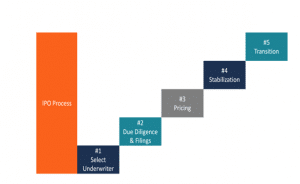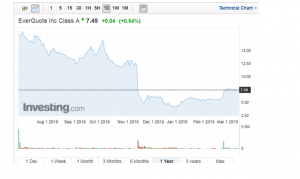INITIAL PUBLIC OFFERING ASSIGNMENT 2020
The main aim of this report is to enhance the knowledge and understanding on the financial market and process of IPO introducing in the financial market. The finding of this report depicts that IPO enables the private company to become a public company and issue the share for raising the money from the market. The finding of the report also determined that EverQuote has launched its IPO in the year 2018 but, the company is not performing well after the introducing the IPO so that it can be said that decision can be bad to invest.
The term IPO is a short form of the Initial Public Offering. It is a vital process that helps a private company to transfer the business in the public company. In this, the company offers the share into the market for the public purchase. It’s meaning that IPO allows the private company to offer the share of the ownership into the market against the money to expand the business (Brigham and Houston, 2012). There are the various reasons for offering the IPO that are the following:
- Each business and company needs money in order to expand the business. IPO allows the company to expand the business.
- IPO is the greatest source of increasing the liquidity of the company. It opens the door for the company to increases the business activities
- IPO is launched with the purpose of increasing the credibility and expand the brand.
In the views of Madura (2011), the initial public offering is a kind of the process in which a previously unlisted company offer to share or securities first time in the financial market. After introducing the IPO, a private company becomes the public company. In the simple meaning, IPO is a just process of becoming a public company.

Step 1: Selection of the investment bank
It is the first step in which the interested firm chooses an investment bank and develops the financial relationship with the bank. At the same time, the bank advised the firms on introducing the IPO and underwriting service.
Step 2: Due diligence and regulatory filings
Underwriting is the process in which a bank makes aware the firm about the rules and regulation of the financial market. In this, the bank also communicates on the responsibility of the firm and bank during the IPO process. In this step, some agreement and contract are also developed between the bank and the firm (Chandra, 2011).
Step 3: Pricing
After the completion of documentation and agreement, the next step is about determining the price and date of introducing the IPO. An IPO always introduced in the market after the IPO is approved by the SEC then the date is decided. The management of the company also decides the price in which share will be launched in the market (Renz, 2016).
Step 4: Stabilization
In this step, the company and management of the company plan and develop the strategy on the stabilization the issues share in the market. It helps the company to maintain the share price in the market and create a profit for the company.
Step 5: Transition to market competition
In this step, IPO issued company deals with the completion in the market. This process starts after the 25 days introducing the public offers.
Use of proceeds – there are various reason from which the process of the IPO is used by a company. In this, repayment of the debt is one of main purpose of company. A firm also use the IPO process to make new investment in the business and for the general corpora purpose. Moreover, some firms are also indented to fixed assets investment, debt repayment, working capital, and purchase the secondary shares.
Managerial capacity – The term managerial capacity in the IPO process refers to the ability of the employees of the company to control and maintain the price of share in the market. It is related to performance of the company because when a company performance goes down then price of IPO also goes down and when a company perform well in the market then its price of IPO goes up. Hence, the role of Managerial capacity is also important in IPO.
Operating policy – In the process of launching the IPO, the operational policies are decided by the security exchange board of country. In the USA financial market, U.S. Securities and Exchange Commission (SEC) set the operational policies and these are followed by a company that is trading in financial market. It is also essential for EverQuote to follow the operational policies.
Syndicate and leading underwriters – The ranking of underwriters depends on the efficiency of the market that controls the syndicate and underwriter. In the financial market, a large IPO is written by the syndicate of the investment banks. In this situation, the largest syndicate takes the position of lead underwriter. In this, during the selling of the share, syndicate keeps some portion as the proceeds fee for the underwriting fee and concession.
EverQuote is one of the company that has introduced its IPO in the USA market in the financial years 2018. The company registered its IPO in the market as working in the information technology sector. EverQuote is a US-based firm that is engaged in offering online insurance (Hull, 2012). The company was founded in the year 2011 that started its business as offering the quotation of the different insurance. At the current time, the company is providing employment more than 200 people. EverQuote is founded by Seth Birnbaum and Tomas Revesz. The company is headquartered in Cambridge, USA (EverQuote, 2019).
Finance performance of the selected IPO

On the basis of the above graph or chart, it can be said that the performance of Ever has declined in the fast years. In this, it can be seen that the company value of the share price of the company declined where no profit to the shareholders of the company. In this, it can be seen that the price of the IPO has fluctuated in the last year (Burtonshaw-Gunn, 2017).
The current statistics show that the previous close is recorded at the 7.23 and open value is recorded at the 7.24. At the current time, the company has issued 78015 shares in the financial market. The financial statistics on Ever also shows that the average volume is 115723 in the market. There is no a significant change in the context of this. Day’s range is identified as 7.07 in the financial statistics of Ever. Moreover, the volume of the 52 weeks range is recorded at the 4.05-22.09. In the same concern of this, the value of the market cap is recorded at 335.98 million. The market statistic also depicts that 45098311 units of the shares are outstanding in the market. Moreover, revenue of the company is recorded at 163.35 million and earning per share is also calculated -2.06. However, the company is not providing the dividend to its shareholders (Kim and Chatterjee, 2013).
In order to calculate the overhand, the following formula can be used
Overhang = (shares outstanding – shares offered) / shares offered
Overhang = (45,098,311 – 58692) / 58692
= 767.38
In the financial analysis, the value of the coefficient B1 depicts the relationship between the underpricing and overhand. In this, it is also determined that when the number of the retained share will increase then the chance of the decreasing the IPO will increase. In the same concern of this, the chance of the underpricing will also increase if the amount of the overhang is found high. The growth and current status on the overhand and pricing can be evaluated from the statistic graph (Christoffersen, 2011).
Probability of under pricing – It is also a significant factor in the financial market that influence the decision of the investor. In this situation, the sales price of the share is sold at the below of the actual price. It is always beneficial for an investor to buy the share at underpriced.
| Descriptive statistics | |
| Mean | 10.36282059 |
| Standard Error | 0.74817359 |
| Median | 11.99 |
| Mode | 5.51 |
| Standard Deviation | 4.672342574 |
| Sample Variance | 21.83078513 |
| Kurtosis | -1.612821889 |
| Skewness | 0.15784867 |
| Range | 13.840001 |
| Minimum | 4.28 |
| Maximum | 18.120001 |
| Sum | 404.150003 |
| Count | 39 |
From the above statistics, it is found the value of the mean is found 10.36 that means that average pricing of the IPO has been remaining approx 10.36. At the same time, it is also found that the value of the standard error, median, and the mode is found approx 0.74, 11.09 and 5.51 respectively. The value of the standard deviation is also found at approx 4.67. The statistic deviation is a significant measure that highlights the financial performance IPO in the market. In this, it is analyzed that it depicts the average variance between each relative point of the mean. This financial statistics also determines that the minimum share price is over the 5 years has been remaining 4.28 and the maximum share price value is found 18.12. Due to this, the value of the range is evaluated at 13.84. Hence, it can be said there has been high fluctuation in the financial performance of the company in the past years 9Parker, 2012).
Financial and industry market conditions and/or cycles – Due to EverQuote is operating in the IT sector that is one of the growing industry at the current time. Nowdays, growth of the each sector depends on the IT sector because information technology has become the part of the each business. In the financial market and Index, it can be seen the weight of IT sector’s companies is high as compared to other sectors. As concerning of the current innovate and growth in IT sector it can be said that it is future of IT and EverQuote is bright. However, company should be careful regarding the security issue and cyber attack in future.
Follow-on Offerings (FOs) volume – FOs is a significant process to raise the more money from the market. In this process, a company issue that additional share in the market compared listed in the stock market during the IPO process. For example, it can be seen that 86029 shares are issued by EverQuote during the IPO process but at the current time, 45098311 shares are outstanding. Hence, it means that 45012282 are FOs.
The correlation determines the relationship between the two variables. In the financial market, when an investor goes to invest in a company then it evaluates where the company performance is relevant with the index or not. Following table depicts the relationship between the EverQuote and S&P 500.
| Ever | S&P | |
| Ever | 1 | |
| S&P | -0.63286 | 1 |
From the above table, it is found that there is a negative relationship between the Ever and S&P. It is because correlation value is found -0.63 that means that there is a strong negative relationship between the financial performances. Hence, the decision on the investment cannot make on the basis of the S&P 500 performance (Moutinho et al., 2018).
Financial strength and industry benchmark(s)
| Ratios | Formula | 2017 |
| Net Profit Margin | (Net Profit/Revenue)*100 | -4.02% |
| Net Profit | -5.07 | |
| Revenue | 126.24 | |
| Return of Equity | (Net Profit/Total Shareholder’s Equity) | -1300.00% |
| Net Profit | -5.07 | |
| Total Shareholder’s Equity | 0.39 | |
| Current Ratio | (Current Assets/Current Liabilities) | 1.18 |
| Current Assets | 17.65 | |
| Current Liabilities | 15.02 | |
| Debt-to-Equity | (Total Debts/Shareholders’ Equity) | 51.62 |
| Total Debts | 20.13 | |
| Total Shareholders’ Equity | 0.39 | |
| Total Assets Turnover | Revenue/total assets | 6.15 |
| Revenue | 126.24 | |
| Total assets | 20.52 | |
| 1. Net Profit Margin | It is a financial ratio that is used to measure the profit percentage of a company generates from its total revenue. In the context of Ever Quote, it is found that the net profit margin is -4.02% in the financial year 2017. It can be seen that Ever do not have a good net profit margin ration that indicates the company is not able to control its price that purchases products and services at prices considerably lower than it costs to provide or produce them. According to this, it is necessary to do the audit process and analyze the financial statement of the business and estimate the research to maximize in the profit (Aebi et al., 2012). |
| 2. Return on Equity | Return on equity is a profitability ratio that measures the firms’ ability to generate profit from its shareholders’ investment. It is a ratio essentially measures the rate of return that the owner of the common stock of a business receives on their shareholdings. Return on equity signifies how good the business is in generating a return on the investment received from its shareholders. In the context of Ever Quote, it is found that ROE is -1300.00% in the financial year 2017. It can be said that the company is not able to reinvest the capital of investors effectively and lack to generate cash internally (Christoffersen, 2011). |
| 3. Current Ratio | This ratio is used to measure the short term liquidity position of the company and also gives a quantitative relationship between current assets and current liabilities. In the context of EverQuote’s financial statement is presenting that the current ratios for the year 2017 are 1.18. It is presenting that the company financial performance is good. Hence, the company does not require conducting any audit process. This ratio presents a desirable situation for the company. The company can pay its debt due within a year out of the current assets (Parker, 2012). |
| 4. Debt-to-Equity | This is a liquidity ratio that presents the financing percentage of the company that comes from investor and creditors. In the context of Ever, it is also found that the debt to equity ratio is 51.62 in the financial year 2017. It represents that the financial situation of the company is riskier for investors and creditors. This could mean that the creditors and investors do not desire to fund the operations of EverQuote because the company is not performing well. It is required for the audit team to analyze the financial statement (Hull, 2012). |
| 5. Total Assets Turnover | It is a common efficiency ratio that measures how a company uses its assets in an efficient way. It measures a firm’s ability to generate sales from its assets or how a company uses its assets for generating sales. In context to this, it is found that the total assets turnover ratio is 6.15 for the financial year 2017 of Ever Quote. It can be said that the EverQuote’s performance is good and in the related trend. Therefore, it can be said in this context that financial statements are good and do not require any audit process (Renz, 2016). |
On the basis of the above discussion, it is found that IPO is a significant process that allows the private company to become a public company. The main benefit of the IPO is that it helps the company to raise the fund from the market. In order to introduce the IPO, the company has to follow the same legal rules and regulations. Moreover, it is also analyzed that EverQuote has introduced its IPO first time in the USA market in the financial year 2018. But, the financial performance of the company is not good because the company is running under the loss. At the same time, the company is not providing a dividend to the shareholder. So that it can be said that the decision to invest in EverQuote is not an effective decision.
Aebi, V., Sabato, G. and Schmid, M., 2012. Risk management, corporate governance, and bank performance in the financial crisis. Journal of Banking & Finance, 36(12), pp.3213-3226.
Brigham, E.F. and Houston, J.F., 2012. Fundamentals of financial management. Cengage Learning.
Burtonshaw-Gunn, S.A., 2017. Risk and financial management in construction. Routledge.
Chandra, P., 2011. Financial management. Tata McGraw-Hill Education.
Christoffersen, P., 2011. Elements of financial risk management. Academic Press.
EverQuote., 2019. Home Page. [Online] Available at https://investors.everquote.com/home/default.aspx.
Hull, J., 2012. Risk management and financial institutions,+ Web Site (Vol. 733). John Wiley & Sons.
Kim, J. and Chatterjee, S., 2013. Childhood Financial Socialization and Young Adults’ Financial Management. Journal of Financial Counseling & Planning, 24(1).
Madura, J., 2011. International financial management. Cengage Learning.
Moutinho, L. and Vargas-Sanchez, A. eds., 2018. Strategic Management in Tourism, CABI Tourism Texts. Cabi.
Parker, L.D., 2012. From privatised to hybrid corporatised higher education: A global financial management discourse. Financial Accountability & Management, 28(3), pp.247-268.
Renz, D.O., 2016. The Jossey-Bass handbook of nonprofit leadership and management. John Wiley & Sons.


